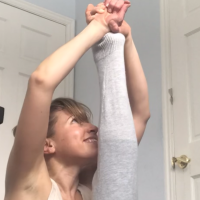How Ashtanga Teaches Me to Avoid the Vortex of Suckiness
I can’t tell you how many times I have asked myself this. I’ve asked it while heading to practice via bus this past winter. Who the f*ck gets up at the crack of dawn, before her toddler (as if I ever get to sleep past 6:30, anyway)?
I’ve asked it recently as I’ve taken to practicing at home alone (and at a more godly hour, thank goodness), since moving away from easy access to any mysore program.
What are you doing? You’re a mostly stay-at-home-mom, so why are you isolating yourself like this? Why are you using babysitter time to do two hours of practice alone?
Then a friend of mine who leads yoga teacher trainings asked me to spend some time with her current trainees. I spent the morning with this lovely little group and we got to talking about my practice—because, frankly, what else do I know better?
I wanted to tell them what I love about ashtanga, and why I do it. Because seriously, when I think about what I am doing—practicing a grueling, demanding asana sequence, usually at home and alone, four to five days a week (I do my best) for almost two hours at a time, by employing a babysitter—it sounds fucking nuts.
From the looks on these trainees’ faces, they agreed.
It has to do with two things that seem as inextricably linked to ashtanga as the idea of breath and movement—practice and progress, which for me, seem to be two sides of the same coin.
“Let me ask you this,” I said to these young women, “Is there a posture out there, one that you’re dying to get into? Just dreaming of the day?”
Oh yes. It did not take long for them to ‘fess up. Handstand. Headstand. Arm balances.
“Right,” I said. “I have a few too.” (Mine mostly involve putting my leg behind my head and moving around with the grace of tinkerbell or, sticking forearm stand and then effortlessly jumping directly back into chattarunga like a yogi badass).
Here’s the thing: I’ve had experiences of actually getting the poses I have long sought after. Dropping back into wheel. Then, standing back up. Supta kurmasana (the first legs-behind-the-head adventure). Headstand (for real). Jumping into bakasana (crow). Advancing from primary series to intermediate series.
And guess what?
Each time I was elated like I was in third grade and school just let out for the summer. But then what? The sky doesn’t crack open releasing a ton of balloons like you’re the 100th shopper. Yoga Journal doesn’t chase you down for a feature interview. The yoga gods don’t come down from the heavens to offer you a plaque inscribed with your name that says “You’ve officially made it as a yogi.”
In fact, it’s a lot like all those other times in my life when I have finally finished that test, graduated from that school, gotten that job, left that job (and the list just goes on). There’s a fleeting moment of pleasure and/or relief, followed by the slow, dawning realization that, “Oh shit! I thought that was going to answer everything, but it didn’t. Oh shit, I thought that when that finally happened, I would be happy!”
I’ve found it doesn’t work like that.
So why, then, is the progress aspect of ashtanga so appealing to me? If those additional elusive postures aren’t going to get me into the yogic pearly gates, who the f%&$ cares, and frankly, why the f&%# am I delaying my breakfast to muddle through a million jump backs and try to get my legs behind my head?
Because practice leads to progress, and that lightning speed, holy-shit-progress reminds me that everything is changing. Even when it looks like it is not.
Let me break it down for you.
Everything is changing, all the time. When I did my vinyasa training, the inimitable Kelly Morris drilled this maxim into us relentlessly. But this idea is everywhere. Buddhism comes to mind first.
I also recall this notion appearing in Swami Satchidananda’s translation of the yoga sutras. I hear that science says it (but since I haven’t taken a science class in a really long time I cannot confirm), and of course, it’s all over my “reliable” source, my Facebook Feed (which is admittedly riddled with yoga teachers’ sound bytes) in the form of lofty quotes floating on top of a pretty picture of a scantily clad yogini or rainbow.
Ch-ch-changes, indeed. It’s so easy for me to hear or see the message that everything is changing and nod my head with an approving “Amen!”
Of course, 10 seconds later, my coffee might spill, I might realize I am out of almond milk and that gray skies and thunderstorms are forecast for the next 10 days and suddenly my bad moment is a bad morning is a bad week, is a bad life.
Suddenly, nothing seems to be changing at all. Welcome to my vortex of suckiness.
I need to be reminded often that change is possible; nothing is stuck. You’d think it would be enough to look at my daughter and see that in a mere two years, she has morphed from an eight pound gurgling blob into a walking, talking creature almost three feet tall.
No, I need something even more tangible.
Because ashtanga calls for commitment and regular practice of the same postures, I have progressed in the past year like nothing I have seen since I was a child. I can do all sorts of things that I could not do a year ago, and, in some cases, things I never thought I would do ever. I can drop back, and stand back up. I can muddle through a jump back (please don’t test me). I can stick my arms through my legs while in lotus. I can perform headstand with confidence. I can attempt forearm stand without fear.
This transformation in such a short period of time, a period of time categorized by mostly regular practice (I have my less than stellar phases though, admittedly), is nothing short of staggering when I think about it.
And that’s just the obvious stuff.
There are also the wallflower poses I regularly do and maybe don’t give all that much thought to, that blossom in ways I never considered (Hello, prasarita, I had no idea it could be like this. Where have you been all my life?). The latter category of progress is what inspires me most now, as I have reached a point where I don’t think I am getting any new postures for a while. Maybe a long while.
So yeah, I care about those other postures, and have faith that one day I’m gonna hit that jump into chattarunga from pincha mayurasana (or just stick pincha, I’d settle for that), but I know that doing so will not make me happy.
“If we can keep at least a bit of the mind clear about temporality, we can mange complicated, even difficult, times with grace.”
~ Sylvia Boorstein
What makes me happy is enjoying a practice that teaches me everyday, in small and big ways, to wake the f&%# up and smell the coffee I just spilled.
It’s all changing, baby.
So, Jean Marie, you can take that spilled coffee and the missing almond milk and the stormy weather and the toddler meltdown and bog yourself down into a vortex of suckiness, or see that story for what it really is, a painful delusion of your own creation.
That’s why I’m f*cking doing this.
Like elephant yoga on Facebook.
Ed: Bryonie Wise











Read 2 comments and reply